Shay Edwards Wins California State Science Fair Competition

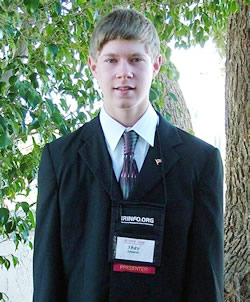 May 23, 2006 (Norco, CA) Corona Norco Unified School District freshman Shay Edwards won second place in this year’s annual California State Science Fair.
May 23, 2006 (Norco, CA) Corona Norco Unified School District freshman Shay Edwards won second place in this year’s annual California State Science Fair.
His entry titled, ‘Thermographic Assessment Of Cold Stimulation On Autonomic Vascular Reactions – Is Thermal Imaging A Useful Tool In Assessing Vascular Reactions?’ was chosen from more than 900 middle and senior high school students during the final round of statewide competition.
In order to compete at the State level, students must first qualify at the regional level before advancing to the State Fair. Edwards won the Sweepstakes Trophy in the Senior Division at the 4 county regional fair on April 19 qualifying him for the State competition for the 4th year in a row.
This year, there were 825 entries from a base of 82,000 students all competing for one of the 71 slots to advance onto the State Fair.
On May 23 the students presented their projects to a panel of 6 research scientists, college professors and professionals. Shay won second place and $250 in the Senior Division Mammalian Biology category with his project.
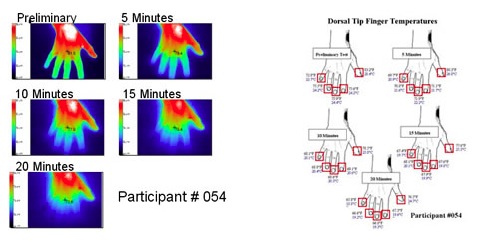
 Shay describes his current and past science fair projects as follows: “I have done testing to see if materials and textures affected infrared viewing. Two years ago I researched if the chemical composition of gas affected viewing in the infrared spectrum. Last year I made a plasma chamber with a germanium window to observe high frequency plasma in the infrared spectrum. This year I got to borrow a Raytek Ti30 thermal imager so I did not have to go to a lab to do any testing. I thought that I would see if an infrared imager could assess vascular differences in smokers, diabetics, versus a control group of people.”
Shay describes his current and past science fair projects as follows: “I have done testing to see if materials and textures affected infrared viewing. Two years ago I researched if the chemical composition of gas affected viewing in the infrared spectrum. Last year I made a plasma chamber with a germanium window to observe high frequency plasma in the infrared spectrum. This year I got to borrow a Raytek Ti30 thermal imager so I did not have to go to a lab to do any testing. I thought that I would see if an infrared imager could assess vascular differences in smokers, diabetics, versus a control group of people.”
Infraspection Institute of Burlington, NJ has been providing support and guidance to Shay since his first science fair competition four years ago. Infraspection Institute’s Director, Jim Seffrin, was particularly thrilled with Shay’s win.
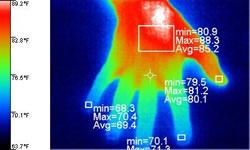 “Working with Shay has been a genuine pleasure. Shay is an intelligent and hard working student. He carefully chooses his projects, never shrinks from a challenge and is meticulous in his fieldwork. We are proud to call Shay and his parents friends.”
“Working with Shay has been a genuine pleasure. Shay is an intelligent and hard working student. He carefully chooses his projects, never shrinks from a challenge and is meticulous in his fieldwork. We are proud to call Shay and his parents friends.”
Shay continues, “I was invited to attend the Infraspection Institute’s annual IR/INFO Conference once again this past January. Many of the IR/INFO Conference attendees participated as subjects in my research. I am very appreciative for everyone’s help. I am especially thankful to Infraspection Institute and Mr. Seffrin for all of his help throughout all of my projects.”
Shay is grateful for the encouragement that fellow thermographers have provided. He adds, “I would like to thank everyone for your emails. If you participated in this research and would like your images and assessment sheet you could email me and I will send it to you.”
If you wish to send a word of encouragement,
or to request your images and assessment sheet,
you may

Project Title: Thermographic Assessment of Cold Stimulation On Autonomic Vascular Reactions
Objective: The objective of this study is to determine the potential usefulness of thermal imaging technology to evaluate and monitor autonomic vascular reactions, and to establish whether thermal imagery can be used to effectively detect pre-clinical stages of circulatory problems.
Materials and Methods: To test my hypothesis as to the effectiveness of thermography as a useful tool for assessing autonomic vascular reactions a cold stimulation test was preformed on 60 participants using a radiometric thermal imager.
The participants included diabetics, smokers, and a normal/control group (no known health issues). The test consists of participants placing their left hand in 62ºF ± 2º water for 20 minutes while the right hand was placed on a wood surface. The participants were also asked to keep the left hand moving while it was submerged in the cool water. Participants were also asked to keep their right hand in a flat comfortable position and to keep movement to a minimum. A thermal image was recorded of the right hand every 5 minutes starting with a preliminary test image.
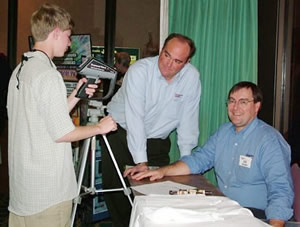
and Jim Seffrin, right at IR/INFO 2006.
Results: Three groups of people were clearly defined by the thermal imager. The diabetic group had no visible thermographic finger tip change while the overall average temperature did decline slightly by an average of 2°F. The smoker group had an extremely mottled and uneven thermographic appearance of all fingers and hand with a slight decline initially in temperature while rising 2°F and holding constant until the end of the 20 minute test period. The normal/control group’s thermographic assessment of the circulatory system showed that the right hand was significantly affected, with a steady decline in surface temperature as much as 10°F (average of 8°F± 2°) and beginning with very visible thermographic finger tips to almost non visible appearance at the end of the 20 minute test period.
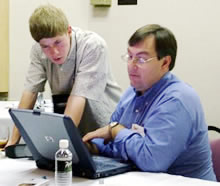
Jim Seffrin, right at IR/INFO 2006.
Conclusions/Discussions: Using three defined groups amazingly showed clear differences in circulation. The data from the test supports my hypothesis that thermal imaging can be a useful tool for examining circulation.
Summary Statement: Thermography simply identifies thermal anomalies using an infrared imager. This research proves that thermal imaging can be used effectively to detect pre-clinical stages of circulatory problems.
If you wish to send a word of encouragement, or to request your images and assessment sheet, you may send
Advertisement

